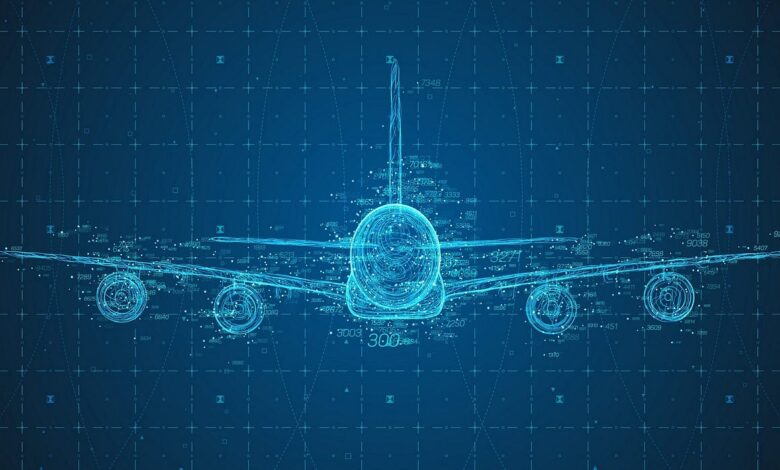Navigating the Future: Advancements in Aviation Solutions

Ever since I attended the 2023 Connected Aviation Intelligence Summit where I heard ideas from industry gurus, it has become clear that aviation is about to make some major technological steps. The future of aviation is being forged through a series of innovations ranging from AI driven approaches and IoT integration. These changes do not only address efficiency but safety issues and how customers are treated.
The Significance of Navigating the Future of Aviation
It is obvious that the future of aviation rests on our ability to adapt to new technological developments as well as customer demands. In this crossroads moment, we must take on a proactive approach to navigating this evolution. As echoed by industry experts, cybersecurity is more than just an afterthought; rather, it should be an integral part of every project plan. In a data-driven world, staying ahead of probable threats becomes necessary for the industry’s continued growth and success.
Technological Innovations
How Technological Changes Have Influenced Aviation
In today’s fast-changing world of aviation, one cannot underestimate the impact brought by technological advances in this field. Being a senior director in commercial marketing with passion for innovation, participating in 2023 Connected Aviation Intelligence Summit gave me insights into how these changes shape tomorrow’s travel by air. The panel discussion highlighted the difficulties and challenges inherent in integrating new technologies into the sector. From advanced analytics for data to cutting-edge AI solutions, digital transformation is becoming a reality across the aviation sector. It no longer surprises anyone though when rapid innovations help operational efficiency or totally reinvent customer experience beyond everyone’s expectations.
Role Played By Artificial intelligence (AI) And Data Analytics In Aviation Solutions
When I delved deeper into these discussions during this summit meeting, artificial intelligence (AI) and data analytics emerged as central elements within the landscape of aviation solutions. On their side some panelists noted that AI can be used to optimize processes while maintaining safety levels within airlines operations. By means of data analytics airlines are now well positioned to make informed business decisions that also account for passengers. It is amazing how AI may completely change predictive maintenance, route optimization, and crew scheduling. Through leveraging the huge amount of available information in this sector, we are headed towards more efficient, secure and environmentally friendly solutions for air travel.
Sustainable Aviation
Attempts to Achieve Sustainable Aviation Practices
While assessing the aviation industry’s shift towards sustainability, I have realized that there is a growing movement towards sustainable aviation practices. In order to achieve a greener future for air travel by Luxurious executive air charters, the sector has adopted innovative approaches aimed at reducing its carbon footprint and addressing environmental issues. Manufacturers of aircrafts as well as airlines and regulatory agencies must collaborate and commit to sustainable operations if they wish to be part of this transformative journey. The industry is making strides in meeting ambitious sustainability goals through initiatives like CORSIA (Carbon Offsetting and Reduction Scheme for International Aviation) and increased utilization of Sustainable Aviation Fuels (SAFs).
Eco-friendly Aircraft Innovations and Alternative Fuels
Innovations in eco-friendly airplanes and alternative fuels are some of the most exciting developments that will shape the future of sustainable aviation. Aircraft manufacturers are putting a lot of investment into research and development to create next-gen aircraft designs that consume less fuel, produce less noise, and emit less pollution. Electric and hybrid-electric propulsion systems are starting to look like attractive substitutes to traditional jet engines because they have the potential to reduce greenhouse gas emissions significantly. Moreover, advances in Sustainable Aviation Fuels (SAFs) have changed how we run our planes with cleaner forms of energy than conventional jet fuel. These innovations demonstrate not only the industry’s commitment to sustainability but also open up an avenue for greener air travel.
Connectivity and Communication
The same cannot be said about connectivity between aviation as well as communication systems.
As I consider what we talked about at this summit, I realized that development in aviation connectivity as well as communication systems is changing how things are done here in this industry. The incorporation of advanced technologies and Advanced s76 cockpit is transforming airlines’ and airports’ relationships with their customers making such interactions more efficient, streamlined operations which improve safety. With Wi-Fi on board, real-time air traffic control-pilot communications, improved efficiency and reliability can be seen across all sectors of the industry. These improvements not only make travelling more comfortable for passengers on-board but they also contribute towards higher quality service delivery.
Benefits of real-time data transmission in aviation operations
One important outcome from the summit was the emphasis placed on real-time data transmission benefits within the aviation operations sphere. Airline companies have been empowered by access to instantaneous information whereby decisions can be made faster after analysis has been conducted. Airlines use advanced technology for flight monitoring; detecting potential maintenance issues before they occur; optimizing fuel consumption through systemized data collection among others. Also, it provides timely warnings about weather patterns, air traffic movements among other risks which enhance safety standards within the airline industry . Real-time data transmission sets a new benchmark for the aviation industry by promoting efficiency, safety and customer satisfaction.
Safety and Security
Advancements in aviation safety measures
Reflecting on our conversations during the summit, it is clear that advancements in aviation security measures are significantly changing air travel. The use of such technologies as predictive maintenance systems and automated safety protocols has raised overall safety levels within the industry. These strategies not only keep passengers and crew safe but also contribute to more reliable and secure air transport environment.
Importance of cybersecurity in aviation solutions
One notable take-away for me was the overriding importance of cybersecurity in aviation solutions. Robust cyber security needs to be embedded into critical aviation infrastructure to protect them from cyber threats and attacks. Consequently, this will ensure stronger data protection and safer operations through embedding cybersecurity at the core of every aviation project. Given the evolving digital threat landscape within which we operate nowadays, this proactive approach to cybersecurity is crucial for ensuring resilience and security of operations across all airline systems.
The aviation industry is now more focused on safety, security and efficiency as technology continues to drive innovation in this sector. In addition, the efforts of stakeholders alongside connectivity, communication improvement, safety measures and cybersecurity among others are setting up a future where advanced technology will be used for air travels guaranteeing the highest possible level of security. The insights we got from the summit have shown us that it is achievable through data-driven solutions and transformative technologies that change how we experience flying.
Optimizing flight routes and operations using novel technologies
Based on the valuable inputs shared by participants at this event, it is clear that this important sector is going through a transformative phase driven by technological innovations. This has led to improved flight routes and operations facilitated by new gadgets being installed in airlines. Through leveraging on Data Analytics and AI-based solutions, airlines are able to optimize their flight paths’ selection as well as reduce fuel usage hence reducing flight time while achieving fuel efficiency at its best. All these developments do not only promote effective running but also advocate for a sustainable nature in aviation.
This section covers reduction of costs related to operating airlines as well as carbon footprint due to efficient measures
Another important issue tackled during this conference was about substantial decrease in both costs and carbon emissions through an increase in productivity/efficiency. Smart technology adoption & data driven ideas ensure cost savings while minimizing the environmental effect of flights by airlines. By taking care of aspects such as schedule maintenance, low use of fuel or sustainability issues for example; the financial savings could go together with environmental concern meaning they can be served concurrently. Consequently, operational excellence coupled with ecological footprints minimization characterize the need for cost effectiveness.
In general terms, ongoing technological progressions as well as focus invested towards making things more efficient are remodeling the Aviation business towards higher levels of progressiveness, sustainability and better operational performance. It is no doubt that embracing these changes while harnessing the power that comes with data is a sure way of achieving an efficient, cost-effective and environmentally sensitive future in aviation.
Improvements in passenger comfort and entertainment
Thinking about these incredible advancements that were discussed at the summit, it is impressive to observe how passenger comfort and entertainment have become two major priorities for the aviation industry. Airline companies are incorporating modern technology into their systems so as to improve the overall flight experiences of their passengers. This means a better air travel experience can be enjoyed through enhanced inflight entertainments or more comfortable seating arrangements among others. The improvement of passenger’s comfort level is an indication of how much the airline industry aims at providing its clientele base with greatest flying experience.
The Aviation Industry – Personalized Services and Experiences
**Personalized services and experiences in the aviation industry**
One of the most interesting discussions that took place during this conference was on personalized services and experiences for customers. Airlines are using data analytics tools as well as AI driven software applications to match specific demands to diverse clients. Food preferences, targeted offers on in-flight amenities such as those with dietary restrictions, among others indicate increased customization options available for travelers. In no time airlines have begun understanding & predicting what passengers want thus making them know one another better than ever. Consequently, personalization demonstrates loyalty enhancement by improving customer satisfaction levels while enabling memorable journeys.
Regulatory Compliance
Adhering to regulations and standards set by the aviation sector
New technologies have led to optimization of flight routes and operations. During the process, it is important to consider compliance with regulations. The importance of ensuring that advancements in data analytics and AI-driven solutions are compliant with aviation regulations cannot be overemphasized. As regulations evolve, we are witnessing efforts towards standardizing how data is collected and processed within the industry. Consequently, this leads to increased operational efficiencies while averting deviation from standards instigating risk controls for secure aviation operations.
Regulatory Compliance: Challenges and Opportunities
Compliance with regulatory obligations in aircraft solutions comes along with challenges and opportunities. On one hand, it may seem difficult due to strict compliance requirements but on the other side it could promote innovation as well as expansion. This challenge is associated with reconciling technology upgrades in relation to governmental regulatory necessities that should also meet the industry standards in order not to compromise safety. However, this difficulty opens up chances for partnership and growth. It is upon the industry to interact proactively with stakeholders including regulators for development of rules fostering creativity while maintaining safety and quality requirements.
If technological advancement in aviation is built upon regulatory compliance, this sector will not only develop into being efficient and optimized but safe too besides environmental friendly aspects. Additionally, Regulatory Compliance gives guidelines on how we can use data-driven approaches towards improving operational efficiencies aligning progressions made with best practices in a particular industry recognized worldwide.
Regulatory compliance isn’t just a legal requirement but also the driving force behind major shifts taking place in the aviation sector today. Therefore the objective stands out as a high priority as a prosperous future would be technologically advanced though at peace from accidents brought by ecologically-friendly productions.
Hence, discussing how important regulatory compliance is when it comes to Efficient aviation solutions highlights its vital role in shaping where the whole industry wants to go. Through compliance, we do not only fulfill statutory requirements; rather, we ensure our product development aligns with industrial norms towards enhancing safety as well as reliability.
The future holds continued integration of further technological advancements within the airline which will leverage data driven solutions innovations enabled by artificial intelligence to improve efficiency and safety. Upon embracing regulatory compliance as a guiding principle, we will be able to go through these changes while maintaining the best standards of quality and safety in flight activities for airlines.



